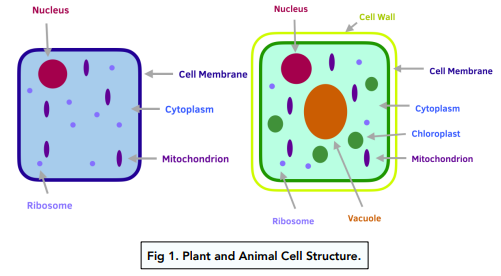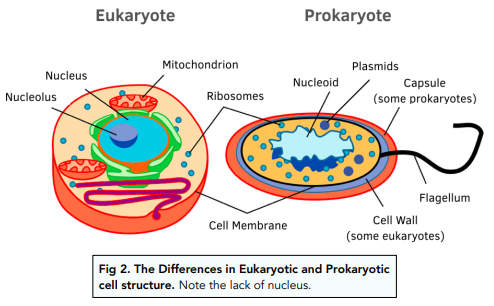Introduction to Cells - Eukaryotes and Prokaryotes (GCSE Biology)
Eukaryotes and Prokaryotes
Eukaryotic Cells
A eukaryotic cell contains a nucleus.
- Plant and animal cells are eukaryotic. A eukaryotic cell tends to be fairly large and complex. Animal and plant cells are both eukaryotic cells.
- Plant and animal cells have common organelles:
- Cell membranes
- Cytoplasm
- Nucleus

Prokaryotic Cells
A prokaryotic cell does not contain a nucleus.
- Bacterial cells are prokaryotic cells. Prokaryotes cells are smaller and more simplistic. One prokaryotic cell forms a unicellular prokaryotic organism.
- Bacterial cells have similarities to plant and animal cells. Animal, plant and bacterial cells all have a cytoplasm and a cell membrane.
- Bacterial cells have a cell wall. In addition to the cell membrane, bacterial cells have a cell wall which surrounds the cell membrane.
- Bacterial cells do not have a nucleus. Instead they have genetic material in a loop. They also have smaller rings of DNA called plasmids.

Cells are the basic unit of life. They are tiny structures that contain all the necessary components to keep an organism alive and carry out its functions.
There are two main types of cells: eukaryotic cells and prokaryotic cells.
Eukaryotic cells are complex cells that contain a nucleus and other membrane-bound organelles. They are found in multicellular organisms such as animals, plants, and fungi.
Prokaryotic cells are simple cells that lack a nucleus and other membrane-bound organelles. They are found in single-celled organisms such as bacteria.
Eukaryotic cells are larger and more complex than prokaryotic cells. They contain a nucleus, which is surrounded by a membrane and holds the cell’s genetic material, as well as other organelles such as mitochondria, chloroplasts, and the endoplasmic reticulum. Prokaryotic cells, on the other hand, do not have a nucleus or other membrane-bound organelles. Instead, their genetic material is located in a single circular chromosome that is not surrounded by a membrane.
Despite their differences, eukaryotic and prokaryotic cells have some similarities. Both types of cells have a plasma membrane that separates the inside of the cell from the outside environment, and both contain ribosomes, which are structures that are involved in protein synthesis.
It is important to understand the differences and similarities between eukaryotic and prokaryotic cells because they are the building blocks of all living things. Understanding their structure and function helps us to better understand the processes that occur within cells, and to develop treatments for diseases and conditions that affect cells.
The structure of cells is directly related to their function. The various organelles and components of a cell are specialized structures that carry out specific functions, such as synthesizing proteins, producing energy, and transporting materials. By studying the structure and function of cells, we can gain a deeper understanding of how they work and how they interact with each other to keep an organism alive.






Still got a question? Leave a comment
Leave a comment